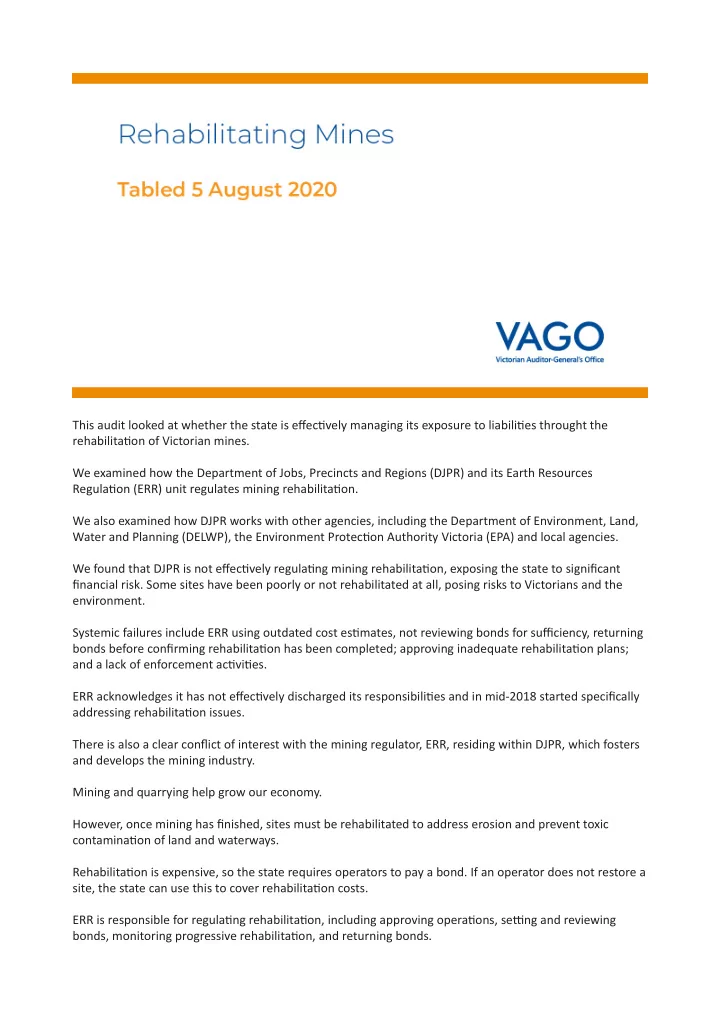

This audit looked at whether the state is efgectjvely managing its exposure to liabilitjes throught the rehabilitatjon of Victorian mines. We examined how the Department of Jobs, Precincts and Regions (DJPR) and its Earth Resources Regulatjon (ERR) unit regulates mining rehabilitatjon. We also examined how DJPR works with other agencies, including the Department of Environment, Land, Water and Planning (DELWP), the Environment Protectjon Authority Victoria (EPA) and local agencies. We found that DJPR is not efgectjvely regulatjng mining rehabilitatjon, exposing the state to signifjcant fjnancial risk. Some sites have been poorly or not rehabilitated at all, posing risks to Victorians and the environment. Systemic failures include ERR using outdated cost estjmates, not reviewing bonds for suffjciency, returning bonds before confjrming rehabilitatjon has been completed; approving inadequate rehabilitatjon plans; and a lack of enforcement actjvitjes. ERR acknowledges it has not efgectjvely discharged its responsibilitjes and in mid-2018 started specifjcally addressing rehabilitatjon issues. There is also a clear confmict of interest with the mining regulator, ERR, residing within DJPR, which fosters and develops the mining industry. Mining and quarrying help grow our economy. However, once mining has fjnished, sites must be rehabilitated to address erosion and prevent toxic contaminatjon of land and waterways. Rehabilitatjon is expensive, so the state requires operators to pay a bond. If an operator does not restore a site, the state can use this to cover rehabilitatjon costs. ERR is responsible for regulatjng rehabilitatjon, including approving operatjons, settjng and reviewing bonds, monitoring progressive rehabilitatjon, and returning bonds.
ERR holds $813 million in bonds—75 per cent for three Latrobe Valley coal mines and the balance for 1 391 sites across Victoria. But it estjmates that this is at least $361 million short of actual rehabilitatjon costs. This is due to ERR’s outdated costjng tools and that there are up to 578 sites with no bond at all. Despite a requirement to do so, ERR has not reviewed over 90 per cent of bonds, and it is also unable to demonstrate that it ensures sites are fully rehabilitated before returning bonds. Contrary to its policy, ERR placed a moratorium (or a pause) on bond reviews between 2013 and 2017. The lack of documented authorisatjon for this breaches transparency and accountability principles, and the decision clearly benefjted operators. ERR is not fully meetjng its legislated responsibilitjes. Rehabilitatjon plans for many sites lack detail. Our review suggests that over half of all approved plans do not comply with regulatjons. Limitatjons in ERR’s monitoring means it is largely unaware of whether operators undertake rehabilitatjon works. To date, it has not issued any enforcement notjces for rehabilitatjon breaches. ERR is also not efgectjvely managing inactjve mines and quarries. These are sites with operators on record that are no longer operatjng and yet to be rehabilitated. Without proper regulatjon, a site may be lefu unrehabilitated indefjnitely. Abandoned and legacy mines present environmental, public health and safety risks, but there is no statewide or proactjve approach to managing them. Neither ERR nor DELWP has comprehensive records on these sites. The 2016 Independent Inquiry into the EPA noted that ERR’s regulatjon of mining-actjvitjes was not to the same level as other like-industries. It fmagged confmict of interest concerns due to ERR’s status as a unit of DJPR that promotes mining investments.
ERR must now refer mining work plan applicatjons to the EPA. However, this is unlikely to address confmict of interest concerns as most regulatory responsibilitjes, including compliance with environmental conditjons, stjll lie with ERR. ERR has begun to address identjfjed weaknesses in its regulatory approach. It has further work to do to ensure its policies and guidance documents, stafg resourcing, and informatjon management system fully support its regulatory responsibilitjes. It also needs to update its memoranda of understanding with DELWP and EPA, including detailing roles and responsibilitjes. We made 10 recommendatjons: • 1 on bond management • 3 on regulatjon practjces • 5 on governance arrangements, and • 1 on addressing confmict of interest. For further informatjon please view the full report on our website www.audit.vic.gov.au.
Recommend
More recommend